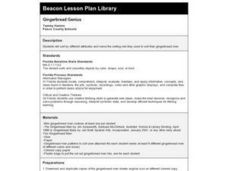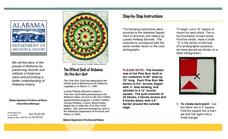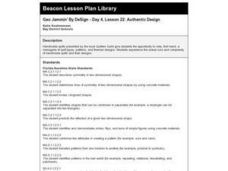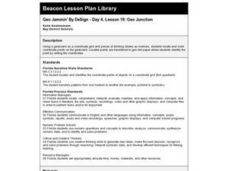Curated OER
Shape Detectives
Students become "shape detectives" as they identify, name, create and describe common shapes within pictures and objects found within the learning environment. Suggestions include incorporating shapes into all learning areas and daily...
Curated OER
The Grouchy Ladybug
Learners learn about sorting and classifying objects by size while reading Eric Carle's "The Grouchy Ladybug". In this sorting and classifying instructional activity, students first listen to and interact with the story. They then look...
Curated OER
Calendar Art
Students assemble and decorate a calendar. This is a lesson to be used at the beginning of each month to make a calendar for the month. Math concepts for this lesson consist of each student writing numbers on the calendar.
Curated OER
Calder's Balancing Acts
Students learn the vocabulary of contemporary sculpture and distinguish between abstract and realistic sculpture, mobile and stabile, biomorphic and geometric. They write equations using Calder's mobiles
Curated OER
Gingerbread Genius
Students sort gingerbread men, then identify the sorting rule that they used.
Curated OER
What's the Texture?
Learners sort, classify, and write about how they sort a variety of shells.
Curated OER
Who Wants Pizza?
Students practice fraction skills online at the "Want Some Pizza" website. They complete activities via the internet and on square grid paper. They pull down tabs to check their answers.
Curated OER
Choose or Lose: The Electoral Process
Students examine the local and national election process. In groups, they brainstorm a list of the issues important to them and compare them to an overall list of issues present in the election. They analyze graphs and complete...
Curated OER
Skip-Counting
In this skip counting math practice worksheet, students complete 2 charts that are missing numbers. Each chart includes numbers from 1-100. Students also highlight even and odd numbers.
Pennsylvania Department of Education
The Weight of Things
Students explore weight. In this math instructional activity, students predict which item weighs more and discuss how they arrived at their decision. Students weigh several items to determine which weighs more.
Curated OER
Plastic Wrap
Students compare the price and quality of different kinds of plastic kitchen wraps and then rank them from best to worst. They take into account how well it comes out of the roll, if it seals well, it is tangles, how much weight it...
Curated OER
Shape Search
Second graders draw a model using correctly formed geometric shapes. In this geometric shapes lesson, 2nd graders notice geometric shapes in the world around them and accurately draw these shapes.
Curated OER
The Official Quilt of Alabama- The Pine Burr Quilt
In this quilting worksheet, students follow the directions to re-create the official quilt of Alabama, The Pine Burr Quilt. They use geometric shapes and stitching directions to make quilt squares.
Curated OER
Primary Geometry
Students identity simple geometric shapes. In this early geometry lesson, the teacher introduces students to triangles, squares, and rectangles, then students identify and classify the shapes as they are found in the classroom. To...
Curated OER
Pumpkin Carving for K-2 Students
Students engage in a variety of pumpkin activities. This lesson plan is especially rich for ESL students, who probably have little experience with this holiday and custom.
Curated OER
Tessellations: An Application of Simple Regular Polygons
Tenth graders identify homogeneous tessellations. In this model-based lesson, 10th graders make and identify homogeneous tessellations, both regular and semi-regular.
Curated OER
Geo Jammin' By DeSign - Day 4, Lesson 22: Authentic Design
Students explore the complexity of handmade quilts and their designs by looking a real life samples.
Curated OER
CHAOS AND COMPUTERS
Students discuss the Chaos Theory and how it came into existence.They observe order and compare it to the randomness of chaos. The lesson features the playing of a game to reinforce concepts.
Curated OER
Confusing Colors!
Fourth graders collect data, graph their data, and then make predictions based upon their findings. They's interest is maintained by the interesting way the data is collected. The data collection experiment is from the psychology work of...
Curated OER
PASS the Arts
Students explore math and art concepts, create digital art examples of the concepts, and incorporate these works into a PowerPoint portfolio with explanation and analysis.
Curated OER
And Around We Go!
Sixth graders conduct a survey and collect data to construct a bar graph that will then be changed into a circle graph. With the bar graph, 6th graders compare estimated fractions and percentages and estimate percentages. With the circle...
Curated OER
Manipulative Mania
Learners explore tangram vocabulary and tangram designs, creating an art design that contains various geometric parts. They complete a checklist titled, Important Thing About a Quilt Design.
Curated OER
Geo Jammin By Design: Geo Junction
Students create pictures using a geoboard and straws using the X and Y axis.
Curated OER
Displaying the Data
Students gather facts about their parent's families through the completion of parent interview forms. Using tally marks, the data gathered is counted, transferred to graphs and used to create family timelines.

























